Towards 4D BIM: A Systematic Literature Review on Challenges, Strategies and Tools in Leveraging AI with BIM
Abstract
1. Introduction
1.1. Study Contributions
1.2. Study Road Map
2. Review Methodology
2.1. Research Questions
- RQ 1: What are the existing limitations in BIM?
- RQ 2: What challenges in AEC/digital construction have been addressed in the literature?
- RQ 3: What are the strategies that can be deployed towards 4D BIM?
- RQ 4: What tools, techniques, and software exist in the research for 4D BIM integration and 4D BIM related research?
- RQ 5: What are the predictive strategies applicable and how are they evaluated?
2.2. Search Process
2.3. Quality Assessment
2.4. Data Collection
2.5. Data Analysis
3. Background
- As a knowledge and information resource;
- As a collaborative tool;
- In terms of content;
- In terms of location;
- As a 3D digital representation, as well as other contexts.
4. Related Research
4.1. Digital Construction: BIM
| Citations | Review Topic | BIM Type | Application Area | Research Method | Gaps and Limitations |
|---|---|---|---|---|---|
| Mesároš et al. [38] | The fifth dimension of BIM—implementation survey | 5D BIM |
| survey |
|
| Abbasnejad et al. [34] |
| BIM |
| SLR |
|
| Zhao and Taib [35] |
| Cloud-BIM |
| SLR |
|
| Bastem and Cekmis [39] | Development of historic building information modeling: a systematic literature review | HBIM |
| SLR |
|
| Alankarage et al. [40] | Organizational BIM maturity models and their applications: a systematic literature review. | BIMMM (BIM maturity model) |
| SLR |
|
| Abanda et al. [41] | A literature review on BIM for cities distributed renewable and interactive energy systems. | BIM-Energy |
| SLR |
|
| Wang and Meng [37] | Transformation from IT-based knowledge management into BIM-supported knowledge management: A literature review | BIM-KM (knowledge management) |
| SLR |
|
| Zabin et al. [6] | Applications of machine learning to BIM: A systematic literature review | BIM-ML (machine learning) |
| SLR |
|
4.2. Lean Systems in BIM
- Digital lean systems;
- Traditional lean ideologies.
4.3. 4D BIM
4.4. BIM Ontology
BIM Ontology-Related Research
5. Challenges in Construction
6. Tools, Techniques and Software in 4D BIM
6.1. Classification of Instruments in 4D BIM
6.1.1. Tools
6.1.2. Techniques
6.1.3. Software
6.1.4. Integration
6.1.5. Methods
6.1.6. File Types
7. Predictive Modeling Strategies
7.1. Computer Vision
7.2. Natural Language Processing
7.3. General Machine Learning
7.4. Summary of Predictive Modeling Strategies
| Technique Domain | Technique | AEC Domain/Processes | Citations |
|---|---|---|---|
| Computer vision | Stochastic gradient descent (SGD), YOLOv8m | Safety (workforce safety monitoring) | Kulinan et al. [130] |
| SOLOv2, PointRend, Yolact, Cascade Mask R-CNN, Mask R-CNN | Status (Progress Monitoring) | Wei et al. [132] | |
| Mask R-CNN, Cascade Mask R-CNN, CNN | Logistics, Safety, material | Yan et al. [131] | |
| YOLOv5 + DeepSORT | Quality (crack defects detection for inspection) | Tan et al. [136] | |
| DeepLabv3+ | Waste (construction waste) | Lu et al. [137] | |
| Review study; ANN, SVM, CNN, etc. | Performance monitoring: equipment and worker activity recognition | Behnam et al. [135] | |
| Support Vector Machines—SVMs; Histograms of Oriented Gradients— HOGs; Histograms of Optical Flow—HOFs; Motion Boundary Histogram—MBH | Action recognition | Yang et al. [133] | |
| SVM, Naı¨ve Bayes, decision trees, k-nearest neighbors, regression, neural networks, boosting algorithms | Document classification | H et al. [138] | |
| Natural Language Processing | Systematic scientometric analysis; BERT, GPT, Neural networks | Communication: Text reasoning | Y. Ding et al. [139] |
| Overview paper; Long Short-Term Memory Recurrent Neural Network LSTM-RNN, Graph Convolutional Neural Network (GCN), Transformer machine learning model | Schedule management | Singh et al. [141] | |
| Support vector machine (SVM), latent semantic analysis (LSA) and latent Dirichlet allocation (LDA) | Text classification | Jung & Lee 2019 [140] | |
| SVM, SVO tagging, PRINCO (Principal Component Analysis) and Random Forest | Design (Bid and tendering, error analysis, changes analysis), Supply chain, Maintenance | Kim et al. [142] | |
| Ontology, Text summarization | Safety | Kim et al. [142] | |
| Review paper, BERT, GPT, LSA, LDA, Word2Vec and its variants (e.g., Sentence2Vec, Doc2Vec), GloVe, and FastText | Construction | Chung et al. [150] | |
| KeyBERT algorithm, BERT-Base, RoBERTa-Base, and fastText | Quality (building defect analysis) | Shooshtarian et al. [143] | |
| GermaNet, SpaCy, or BERT. | Design, Sustainability (GHG) | Forth et al. [144] | |
| Machine Learning | Review paper, ML, RDF, ANN, SVM, CONVNETS, GA, DT | Schedule creation, performance monitoring, cost estimation, risk identification, knowledge-based bim system, energy management system, localization, maintenance prediction | Zabin et al. [6] |
| Random forest classifier, decision trees, frequent item set analysis ‘FIA’ | Facility management | McArthur et al. [145] | |
| Random Forest (RF) and Stochastic Gradient Tree Boosting (SGTB), | Safety (injury prediction) | Tixier et al. [146] | |
| CNN, SVM, RF | Risk monitoring | PourRahimian et al. [148] | |
| SVM, KNN, RF. Ensemble techniques, CNN, FCN, WNN, DGCNN, RNN, MVCNN, RANSAC, PCA | Lifecycle safety analysis, quality, performance monitoring | Mirzaei et al. [149] | |
| Multiple linear regression, multi-layer perceptron (MLR) | Design (implication of design changes) | Abdulfattah et al. [151] |
7.5. Evaluation Methods
| Ref | Domain | Prediction Strategy | Cm | mAP | PR Curve | Acc % | Precision % | Recall % | F1 Score % |
|---|---|---|---|---|---|---|---|---|---|
| [152] | CV–CAD object classification | convolutional deep belief network (CDBN) | no | - | no | - | 42–62 | - | - |
| [130] | CV–worker/ safety object classification | YOLOv8m | no | 92.3 | yes | - | 88.3 | 89.3 | - |
| [70] | ML-work productivity prediction | MLP (adam), Histogram based gradient boosting, stacking MLP SGD, | yes | - | no | 86.2, 93.8, 90.8 | 86.2, 93.9, 91.1 | 86.2, 93.8, 90.8 | 86.2, 93.85, 90.95 |
| [159] | CV-progress monitoring | Mask R-CNN | no | 92.6 | yes | - | - | - | - |
| [140] | NLP case study classification | LSA, LDA, SVM | 100 | 27 | 41.82 | ||||
| [157] | CV-Princeton modelnet leaderboard-volumetric/ geometric classification | Convolutional Deep Belief Network | yes | 68.26 | yes | 83.54 | - | - | - |
| [155] | CV-volumetric/geometric classification | LP-3DCNN | no | - | no | 94.4 | - | - | - |
| [154] | CV-Multiview recognition | pairwise | no | - | no | 0.907 | - | - | - |
| [156] | CV-Varied orientation recognition | Orions | no | - | yes | 89.7 | - | - | - |
| [153] | CV-Voxel-based representation for object recognition | VRN ensemble | no | - | no | 97.14 | - | - | - |
8. Discussion
8.1. RQ 1: What Are the Existing Limitations in BIM?
8.2. RQ 2: What Challenges in AEC/Digital Construction Have Been Addressed in the Literature?
8.3. RQ 3: What Are the Strategies That Can Be Deployed Towards 4D BIM
8.4. RQ 4: What Tools, Techniques, and Software Exist in the Research for the Integration of 4D BIM?
9. Open Issues
- Adoption and implementation of BIM is generally determined to be a limitation in BIM research. The barriers associated with the adoption of 4D BIM software should be further analyzed to achieve a consensus on how advancements in AI can facilitate automation, enhance training, and improve usability [160,161].
- Existing use cases of 4D BIM are visualization, performance monitoring, safety, progress monitoring, scheduling and planning, decision making, and integration [5,50,51]. However, in construction, there are other unexplored aspects such as instant risk insights, project continuation/closure, and evaluation, project benefit evaluation-earned value analysis, project securing (i.e., automated bid and tendering), etc. These areas should be further explored with real project pilot case studies for validation.
- Discussions regarding digitized support and combination of technologies such as AI, IoT, Cloud storage, AR, and VR are common [162,163]. However, there is not enough analytical research detailing the outcomes of each of the combinations and their importance for the sustainability and progress of digital construction.
- Other gaps in 4D BIM-related research:
- (a)
- Inability to generalize 4D BIM solutions: This is a recurrent limitation in most 4D BIM studies across different projects, contexts and organizations. Factors leading to such limitations include complexities and uniqueness of projects embarked on in construction, tailored schedules that do not match 3D BIM information, software compatibility, and inconsistent data standards, leading to data losses and nonquality data [51,58,59,60,61].
- (b)
- Lack of Integrated Decision-Making Support in 4D BIM Systems: The majority of businesses in AEC, projects, processes, and domains operate with siloed data that comprise different formats and types; for example, schedules and 3D drawings are created independently without collaborative efforts between designers, engineers, and planners. These disparate data sources only lead to fragmented information, making it difficult to draw instant project or business insights. Thus, analytical capabilities are limited and can be prone to undue errors and inconsistencies [51,62].
- (c)
- Limited research documentation and regulation in 4D BIM: The small amount of research documentation of 4D BIM, coupled with unavailable standardized protocols that are non-existent in many regions of the world, are determined as additional limitations in this regard. Going forward, it is important to promote academic research in this area and enhance the promotion of using standardized data formats alongside APIs [59,60].
- (d)
- Lack of automation (AI) in 4D BIM: The manual method of data integration and lack of automation in 4D BIM is a major limitation that impedes accuracy, consistency, and effectiveness in project management. Without AI, it is impossible to take a proactive approach and generate actionable insights instantly. It is, however, important to take an AI-driven approach to building 4D BIM solutions [5,60].
- BIM ontology reviews indicate the need for further research and development. Although several BIM modules have standardized and validated ontological, structures such as time, dimension, GIS, safety, quality, planning, and other modules that are developed and validated by standard regulatory bodies, there are other lower-level modules or domains such as predictive maintenance systems for energy systems, predictive failure modules, automated machinery systems and other relatively new models which require integration with BIM to function. Also, other linkages, such as safety-schedule-BIM ontology, schedule-BIM ontology, etc., are still unexplored. This shows that there is a need for further research to overcome the continuous integration challenge experienced across the board in digital construction.
- The level of detail (LOD) in 4D BIM is unexplored [164,165,166]. There is a need for the analysis of LOD in 4D BIM solutions for entity integration, data extraction, design and implementation workflow analysis, automation, production control, visual management, etc. It is important to systematically and analytically determine the level of detail for all process steps regarding 4D BIM and all integrated digital construction systems.
10. Conclusions
Author Contributions
Funding
Data Availability Statement
Acknowledgments
Conflicts of Interest
References
- Salman, A. Building Information Modeling (BIM): Trends, Benefits, Risks, and Challenges for the AEC Industry. Leadersh. Manag. Eng. 2011, 11, 241–252. [Google Scholar] [CrossRef]
- NBIMS-US. NBIMS-US™ v3 | National Institute of Building Sciences. 2024. Available online: https://nibs.org/nbims/v3 (accessed on 19 February 2025).
- Rahman, I.A.; Memon, A.H.; Karim, A.T.A.; Tarmizi, A. Significant factors causing cost overruns in large construction projects in Malaysia. J. Appl. Sci. 2013, 13, 286–293. [Google Scholar] [CrossRef]
- Larsen, J.K.; Shen, G.Q.; Lindhard, S.M.; Brunoe, T.D. Factors affecting schedule delay, cost overrun, and quality level in public construction projects. J. Manag. Eng. 2016, 32, 04015032. [Google Scholar] [CrossRef]
- Crowther, J.; Ajayi, S. Impacts of 4D BIM on construction project performance. Int. J. Constr. Manag. 2019, 21, 724–737. [Google Scholar]
- Zabin, A.; González, V.A.; Zou, Y.; Amor, R. Applications of machine learning to BIM: A systematic literature review. Adv. Eng. Inform. 2022, 51, 101474. [Google Scholar] [CrossRef]
- Dave, B.; Sacks, R. Production control systems for construction at the nexus of Lean and BIM. In Lean Construction Core Concepts and New Frontiers; Routledge: London, UK, 2020; Chapter 4; pp. 54–84. [Google Scholar] [CrossRef]
- Hosseini Gourabpasi, A.; Nik-Bakht, M. An ontology for automated fault detection & diagnostics of HVAC using BIM and machine learning concepts. Sci. Technol. Built Environ. 2024, 30, 972–988. [Google Scholar]
- Manzoor, B.; Othman, I.; Pomares, J.C. Digital technologies in the architecture, engineering and construction (Aec) industry—A bibliometric—Qualitative literature review of research activities. Int. J. Environ. Res. Public Health 2021, 18, 6135. [Google Scholar] [CrossRef]
- Kitchenham, B.; Pearl Brereton, O.; Budgen, D.; Turner, M.; Bailey, J.; Linkman, S. Systematic literature reviews in software engineering—A systematic literature review. Inf. Softw. Technol. 2009, 51, 7–15. [Google Scholar] [CrossRef]
- Borkowski, A. A Literature Review of BIM Definitions: Narrow and Broad Views. Technologies 2023, 11, 176. [Google Scholar] [CrossRef]
- Azhar, S.; Khalfan, M.; Maqsood, T. Building Information Modeling (BIM): Now and Beyond. Australas. J. Constr. Econ. Build. 2012, 12, 15–28. [Google Scholar] [CrossRef]
- Borkowski, A.S. Evolution of BIM: Epistemology, genesis and division into periods. J. Inf. Technol. Constr. 2023, 28, 646–661. [Google Scholar]
- Majrouhi, S.J.; Hamid, M.Y.; Abolfazl, A. An Investigation into the Integration of Building Information Modeling with Pre-Construction Industry in the Developed Countries and Iran. In Proceedings of the Creative Construction e-Conference 2020, Opatija, Croatia, 28 June–1 July 2020. [Google Scholar]
- Borrmann, A.; König, M.; Koch, C.; Beetz, J. Building Information Modeling: Why? What? How? Springer International Publishing: Berlin, Germany, 2018. [Google Scholar]
- Wen, Q.J.; Ren, Z.j.; Lu, H.; Wu, J.F. The progress and trend of BIM research: A bibliometrics-based visualization analysis. Autom. Constr. 2021, 124, 103558. [Google Scholar]
- Skandhakumar, N.; Reid, J.; Dawson, E.; Drogemuller, R.; Salim, F. An Authorization Framework using Building Information Models. Comput. J. 2012, 55, 1244–1264. [Google Scholar]
- Succar, B. Building information modelling framework: A research and delivery foundation for industry stakeholders. Autom. Constr. 2009, 18, 357–375. [Google Scholar]
- Tsai, W.T.; Lee, Y.H.; Wiezel, A.; Sun, X.; Li, W. Ontology-Based Service Composition Framework for Syndicating Building Intelligence. In Proceedings of the 2009 IEEE Conference on Commerce and Enterprise Computing, Vienna, Austria, 20–23 July 2009; pp. 445–452. [Google Scholar]
- Mihindu, S.; Arayici, Y. Digital Construction through BIM Systems will Drive the Re-engineering of Construction Business Practices. In Proceedings of the 2008 International Conference Visualisation, London, UK, 9–11 July 2008; pp. 29–34. [Google Scholar] [CrossRef]
- Iyiola, C.O.; Shakantu, W.; Daniel, E.I. Digital Technologies for Promoting Construction and Demolition Waste Management: A Systematic Review. Building 2024, 14, 3234. [Google Scholar] [CrossRef]
- Ametepey, S.O.; Aigbavboa, C.; Addy, H.; Thwala, W.D. A Bibliometric Review of the Trends of Construction Digitalization Research in the Past Ten Years. Building 2024, 14, 2729. [Google Scholar] [CrossRef]
- Liu, Z.; Lu, Y.; Peh, L.C. A review and scientometric analysis of global building information modeling (BIM) research in the architecture, engineering and construction (AEC) industry. Buildings 2019, 9, 210. [Google Scholar] [CrossRef]
- Korkmaz, S. A review of active structural control: Challenges for engineering informatics. Comput. Struct. 2011, 89, 2113–2132. [Google Scholar] [CrossRef]
- Demirkesen, S.; Ozorhon, B. Impact of integration management on construction project management performance. Int. J. Proj. Manag. 2017, 35, 1639–1654. [Google Scholar]
- Harris, F.; McCaffer, R.; Baldwin, A.; Edum-Fotwe, F. Modern Construction Management; John Wiley & Sons: Hoboken, NJ, USA, 2021. [Google Scholar]
- Fewings, P.; Henjewele, C. Construction Project Management: An Integrated Approach; Routledge: London, UK, 2019. [Google Scholar]
- Baldwin, A.; Bordoli, D. Handbook for Construction Planning and Scheduling; John Wiley & Sons: Hoboken, NJ, USA, 2014. [Google Scholar]
- Delgado, J.M.D.; Oyedele, L.; Ajayi, A.; Akanbi, L.; Akinade, O.; Bilal, M.; Owolabi, H. Robotics and automated systems in construction: Understanding industry-specific challenges for adoption. J. Build. Eng. 2019, 26, 100868. [Google Scholar]
- Sediqi, M. 4D BIM Adoption: The Incentives for and Barriers to 4D BIM Adoption Within Swedish Construction Companies. 2018. Available online: https://api.semanticscholar.org/CorpusID:51804346 (accessed on 19 February 2025).
- Alghamdi, M.S.; Beach, T.H.; Rezgui, Y. Reviewing the effects of deploying building information modelling (BIM) on the adoption of sustainable design in Gulf countries: A case study in Saudi Arabia. City Territ. Archit. 2022, 9, 18. [Google Scholar] [CrossRef]
- Jung, W.; Lee, G. The Status of BIM Adoption on Six Continents. J. Civ. Environ. Eng. 2015, 9, 512–516. [Google Scholar]
- Gu, N.; London, K. Understanding and facilitating BIM adoption in the AEC industry. Autom. Constr. 2010, 19, 988–999. [Google Scholar] [CrossRef]
- Abbasnejad, B.; Nepal, M.P.; Ahankoob, A.; Nasirian, A.; Drogemuller, R. Building Information Modelling (BIM) adoption and implementation enablers in AEC firms: A systematic literature review. Archit. Eng. Des. Manag. 2021, 17, 411–433. [Google Scholar] [CrossRef]
- Zhao, Y.; Taib, N. Cloud-based Building Information Modelling (Cloud-BIM): Systematic literature review and Bibliometric-qualitative Analysis. Autom. Constr. 2022, 142, 104468. [Google Scholar] [CrossRef]
- Rocha, L.S.; Krassmann, A.L.; Notare, M.R.; Vidotto, K.N.S. BIM associated with virtual and augmented reality resources in an educational context: A systematic literature review. Interact. Learn. Environ. 2024, 33, 452–465. [Google Scholar]
- Wang, H.; Meng, X. Transformation from IT-based knowledge management into BIM-supported knowledge management: A literature review. Expert Syst. Appl. 2019, 121, 170–187. [Google Scholar] [CrossRef]
- Mesároš, P.; Smetanková, J.; Mandičák, T. The Fifth Dimension of BIM—Implementation Survey. IOP Conf. Ser. Earth Environ. Sci. 2019, 222, 012003. [Google Scholar] [CrossRef]
- Bastem, S.S.; Cekmis, A. Development of historic building information modelling: A systematic literature review. Build. Res. Inf. 2022, 50, 527–558. [Google Scholar] [CrossRef]
- Alankarage, S.; Chileshe, N.; Samaraweera, A.; Rameezdeen, R.; Edwards, D.J. Organisational BIM maturity models and their applications: A systematic literature review. Archit. Eng. Des. Manag. 2023, 19, 567–585. [Google Scholar]
- Abanda, F.H.; Sibilla, M.; Garstecki, P.; Anteneh, B.M. A literature review on BIM for cities Distributed Renewable and Interactive Energy Systems. Int. J. Urban Sustain. Dev. 2021, 13, 214–232. [Google Scholar] [CrossRef]
- Uvarova, S.S.; Orlov, A.K.; Kankhva, V.S. Ensuring efficient implementation of lean construction projects using building information modeling. Buildings 2023, 13, 770. [Google Scholar] [CrossRef]
- Bayhan, H.G.; Demirkesen, S.; Zhang, C.; Tezel, A. A lean construction and BIM interaction model for the construction industry. Prod. Plan. Control 2023, 34, 1447–1474. [Google Scholar] [CrossRef]
- Dave, B.; Hämäläinen, J.P.; Koskela, L. Exploring the Recurrent Problems in the Last Planner Implementation on Construction Projects. In Proceedings of the Indian Lean Construction Conference (ILCC 2015), Mumbai, India, 5 February 2015. [Google Scholar]
- Tauriainen, M.; Marttinen, P.; Dave, B.; Koskela, L. The Effects of BIM and Lean Construction on Design Management Practices. Procedia Eng. 2016, 164, 567–574. [Google Scholar] [CrossRef]
- Ballard, G. The Last Planner System of Production Control. Doctoral Dissertation, University of Birmingham, Birmingham, UK, 2000. [Google Scholar]
- Dave, B.; Kubler, S.; Främling, K.; Koskela, L. Opportunities for enhanced lean construction management using Internet of Things standards. Autom. Constr. 2016, 61, 86–97. [Google Scholar] [CrossRef]
- Sacks, R.; Koskela, L.; Dave, B.A.; Owen, R. Interaction of lean and building information modeling in construction. J. Constr. Eng. Manag. 2010, 136, 968–980. [Google Scholar] [CrossRef]
- Gerber, D.J.; Becerik-Gerber, B.; Kunz, A. Building Information Modeling and Lean Construction: Technology, Methodology and Advances from Practice. 2010. Available online: https://api.semanticscholar.org/CorpusID:13917181 (accessed on 19 February 2025).
- Jupp, J. 4D BIM for Environmental Planning and Management. Procedia Eng. 2017, 180, 190–201. [Google Scholar] [CrossRef]
- Gledson, B.J.; Greenwood, D. The adoption of 4D BIM in the UK construction industry: An innovation diffusion approach. Eng. Constr. Archit. Manag. 2017, 24, 950–967. [Google Scholar] [CrossRef]
- Srinivasan, R.; Kibert, C.; Thakur, S.; Ahmed, I.; Fishwick, P.; Ezzell, Z.; Lakshmanan, J. Preliminary research in dynamic-BIM (D-BIM) workbench development. In Proceedings of the Winter Simulation Conference, Berlin, Germany, 9–12 December 2012. [Google Scholar]
- Sampaio, A.Z. 4D/BIM model linked to VR technology. In Proceedings of the Virtual Reality International Conference—Laval Virtual 2017, New York, NY, USA, 22–24 March 2017. [Google Scholar] [CrossRef]
- Charlesraj, V.P.C.; Dinesh, T. Status of 4D BIM Implementation in Indian Construction. In Proceedings of the 37th International Symposium on Automation and Robotics in Construction (ISARC), Online, 27–28 October 2020; pp. 199–206. [Google Scholar] [CrossRef]
- Umar, U.A.; Shafiq, N.; Malakahmad, A.; Nuruddin, M.F.; Khamidi, M.F. 4D BIM Application in AEC Industry: Impact on Integrated Project Delivery. Res. J. Appl. Sci. Eng. Technol. 2015, 10, 547–552. [Google Scholar] [CrossRef]
- Park, J.; Cai, H. Framework of Dynamic Daily 4D BIM for Tracking Construction Progress through a Web Environment. In Computing in Civil Engineering; American Society of Civil Engineers: Reston, VA, USA, 2017. [Google Scholar]
- Park, J.; Cai, H.; Dunston, P.S.; Ghasemkhani, H. Database-Supported and Web-Based Visualization for Daily 4D BIM. J. Constr. Eng. Manag. ASCE 2017, 143, 4017078. [Google Scholar] [CrossRef]
- Vtt, K.K.; Kähkönen, K. 4D-BIM for Construction Safety Planning. 2010. Available online: https://api.semanticscholar.org/CorpusID:28502950 (accessed on 19 February 2025).
- Montaser, A.; Moselhi, O. Methodology for Automated Generation of 4D BIM. 2015. Available online: https://api.semanticscholar.org/CorpusID:55859151 (accessed on 19 February 2025).
- Doukari, O.; Seck, B.; Greenwood, D. The Creation of Construction Schedules in 4D BIM: A Comparison of Conventional and Automated Approaches. Buildings 2022, 12, 1145. [Google Scholar] [CrossRef]
- Raut, S.P. Improve the Productivity of Building Project using Building Information Modelling (BIM) Based 4d Simulation Model. Int. J. Res. Appl. Sci. Eng. Technol. 2017, 5, 53–61. [Google Scholar] [CrossRef]
- Bolshakova, V.; Guerriero, A.; Halin, G. Identification of relevant project documents to 4D BIM uses for a synchronous collaborative decision support. In Proceedings of the Creative Construction Conference 2018, Ljubljana, Slovenia, 30 June–3 July 2018. [Google Scholar] [CrossRef]
- Salman, N.; Hamadeh, M. The Integration of Virtual Design and Construction (VDC) With the Fourth Dimension of Building Information Modeling (4D BIM). Int. J. Bim Eng. Sci. 2023, 7, 8–27. [Google Scholar]
- Harris, B.N.; da Costa Lago Alves, T. 4D Building Information Modeling and Field Operations: An Exploratory Study. In Proceedings of the 21st Annual Conference of the Internation Group for Lean Construction, Fortaleza, Brazil, 29 July–2 August 2013. [Google Scholar]
- Martins, S.S.; Evangelista, A.C.J.; Hammad, A.W.A.; Tam, V.W.Y.; Haddad, A. Evaluation of 4D BIM tools applicability in construction planning efficiency. Int. J. Constr. Manag. 2022, 22, 2987–3000. [Google Scholar] [CrossRef]
- Banfi, F.; Brumana, R.; Salvalai, G.; Previtali, M. Digital twin and cloud BIM-XR platform development: From scan-to-BIM-to-DT process to a 4D multi-user live app to improve building comfort, efficiency and costs. Energies 2022, 15, 4497. [Google Scholar] [CrossRef]
- Aredah, A.S.; Baraka, M.; Elkhafif, M. The Fourth Dimension of Building Information Modelling (4D Bim): An Investigation and Simulation Approach. Int. J. Constr. Proj. Manag. 2021, 13, 195–213. [Google Scholar]
- Tan, Y.; Fang, Y.; Zhou, T.; Gan, V.J.L.; Cheng, J.C.P. BIM-supported 4D acoustics simulation approach to mitigating noise impact on maintenance workers on offshore oil and gas platforms. Autom. Constr. 2019, 100, 1–10. [Google Scholar] [CrossRef]
- Ji, Y.; Leite, F. Automated tower crane planning: Leveraging 4-dimensional BIM and rule-based checking. Autom. Constr. 2018, 93, 78–90. [Google Scholar] [CrossRef]
- Sadatnya, A.; Sadeghi, N.; Sabzekar, S.; Khanjani, M.; Tak, A.N.; Taghaddos, H. Machine learning for construction crew productivity prediction using daily work reports. Autom. Constr. 2023, 152, 104891. [Google Scholar] [CrossRef]
- Tran, S.V.T.; Nguyen, T.L.; Chi, H.L.; Lee, D.; Park, C. Generative planning for construction safety surveillance camera installation in 4D BIM environment. Autom. Constr. 2022, 134, 104103. [Google Scholar] [CrossRef]
- Liu, A.H.; Ellul, C.; Swiderska, M. Decision making in the 4th dimension—Exploring use cases and technical options for the integration of 4D BIM and GIS during construction. ISPRS Int. J. Geo-Inf. 2021, 10, 203. [Google Scholar] [CrossRef]
- Natephra, W.; Motamedi, A.; Yabuki, N.; Fukuda, T. Integrating 4D thermal information with BIM for building envelope thermal performance analysis and thermal comfort evaluation in naturally ventilated environments. Build. Environ. 2017, 124, 194–208. [Google Scholar] [CrossRef]
- Bortolini, R.; Formoso, C.T.; Viana, D.D. Site logistics planning and control for engineer-to-order prefabricated building systems using BIM 4D modeling. Autom. Constr. 2019, 98, 248–264. [Google Scholar] [CrossRef]
- Boton, C. Supporting constructability analysis meetings with Immersive Virtual Reality-based collaborative BIM 4D simulation. Autom. Constr. 2018, 96, 1–15. [Google Scholar] [CrossRef]
- Kropp, C.; Koch, C.; König, M. Interior construction state recognition with 4D BIM registered image sequences. Autom. Constr. 2018, 86, 11–32. [Google Scholar] [CrossRef]
- Magill, L.J.; Jafarifar, N.; Watson, A.; Omotayo, T. 4D BIM integrated construction supply chain logistics to optimise on-site production. Int. J. Constr. Manag. 2022, 22, 2325–2334. [Google Scholar] [CrossRef]
- Han, K.K.; Cline, D.; Golparvar-Fard, M. Formalized knowledge of construction sequencing for visual monitoring of work-in-progress via incomplete point clouds and low-LoD 4D BIMs. Adv. Eng. Inform. 2015, 29, 889–901. [Google Scholar] [CrossRef]
- Han, K.K.; Golparvar-Fard, M. Appearance-based material classification for monitoring of operation-level construction progress using 4D BIM and site photologs. Autom. Constr. 2015, 53, 44–57. [Google Scholar]
- Wang, L.; Li, J.; Ye, Q.; Li, Y.; Feng, A. Automatic Planning Method of Construction Schedule under Multi-Dimensional Spatial Resource Constraints. Building 2024, 14, 3231. [Google Scholar] [CrossRef]
- Koutamanis, A. Dimensionality in BIM: Why BIM cannot have more than four dimensions? Autom. Constr. 2020, 114, 103153. [Google Scholar]
- Tchouanguem, J.F.; Karray, M.H.; Foguem, B.K.; Magniont, C.; Abanda, F.H.; Smith, B. BFO-based ontology enhancement to promote interoperability in BIM. Appl. Ontol. 2021, 16, 453–479. [Google Scholar] [CrossRef]
- International Standard. ISO/IEC 21838-2:2021—Information Technology—Top-Level Ontologies (TLO)—Part 2: Basic Formal Ontology (BFO). 2021. Available online: https://www.iso.org/standard/74572.html (accessed on 19 February 2025).
- International Standard. ISO 12006-2:2015—Building Construction—Organization of Information About Construction Works—Part 2: Framework for Classification. 2015. Available online: https://www.iso.org/standard/61753.html (accessed on 19 February 2025).
- Zheng, Y.; Törmä, S.; Seppänen, O. A shared ontology suite for digital construction workflow. Autom. Constr. 2021, 132, 103930. [Google Scholar] [CrossRef]
- Pauwels, P.; Zhang, S.; Lee, Y.C. Semantic web technologies in AEC industry: A literature overview. Autom. Constr. 2017, 73, 145–165. [Google Scholar] [CrossRef]
- Boje, C.; Bolshakova, V.; Guerriero, A.; Kubicki, S.; Halin, G. Ontology assisted collaboration sessions on 4D BIM. In Proceedings of the Creative Construction Conference 2019, Budapest, Hungary, 29 June–2 July 2019; Available online: https://hal.science/hal-02555769 (accessed on 19 February 2025).
- Boje, C.; Bolshakova, V.; Guerriero, A.; Kubicki, S.; Halin, G. Semantics for linking data from 4D BIM to digital collaborative support. Front. Eng. Manag. 2022, 9, 104–116. [Google Scholar] [CrossRef]
- Weber, J.; Stolipin, J.; König, M.; Wenzel, S. Ontology for logistics requirements on a 4D BIM for semi-automatic storage space planning. In Proceedings of the 36th International Symposium on Automation and Robotics in Construction (ISARC), Banff, Canada, 21–24 May 2019; pp. 560–567. [Google Scholar] [CrossRef]
- Guévremont, M.; Hammad, A. Ontology for linking delay claims with 4D simulation to analyze effects-causes and responsibilities. J. Leg. Aff. Disput. Resolut. Eng. Constr. 2021, 13, 04521024. [Google Scholar] [CrossRef]
- Pauen, N.; Frisch, J.; van Treeck, C. Integrated representation of technical systems with BIM and linked data: TUBES system ontology. Autom. Constr. 2024, 165, 105502. [Google Scholar] [CrossRef]
- Zhou, Y.; Bao, T.; Shu, X.; Li, Y.; Li, Y. BIM and ontology-based knowledge management for dam safety monitoring. Autom. Constr. 2023, 145, 104649. [Google Scholar] [CrossRef]
- Ding, L.Y.; Zhong, B.T.; Wu, S.; Luo, H.B. Construction risk knowledge management in BIM using ontology and semantic web technology. Saf. Sci. 2016, 87, 202–213. [Google Scholar] [CrossRef]
- Lee, D.Y.; Chi, H.l.; Wang, J.; Wang, X.; Park, C.S. A linked data system framework for sharing construction defect information using ontologies and BIM environments. Autom. Constr. 2016, 68, 102–113. [Google Scholar]
- Park, C.S.; Lee, D.Y.; Kwon, O.S.; Wang, X. A framework for proactive construction defect management using BIM, augmented reality and ontology-based data collection template. Autom. Constr. 2013, 33, 61–71. [Google Scholar]
- Tavakolan, M.; Mohammadi, S.; Zahraie, B. Construction and resource short-term planning using a BIM-based ontological decision support system. Can. J. Civ. Eng. 2021, 48, 75–88. [Google Scholar] [CrossRef]
- Lee, S.K.; Kim, K.R.; Yu, J.H. BIM and ontology-based approach for building cost estimation. Autom. Constr. 2014, 41, 96–105. [Google Scholar]
- Ren, G.; Li, H.; Liu, S.; Goonetillake, J.; Khudhair, A.; Arthur, S. Aligning BIM and ontology for information retrieve and reasoning in value for money assessment. Autom. Constr. 2021, 124, 103565. [Google Scholar]
- Liu, H.; Lu, M.; Al-Hussein, M. Ontology-based semantic approach for construction-oriented quantity take-off from BIM models in the light-frame building industry. Adv. Eng. Inform. 2016, 30, 190–207. [Google Scholar]
- Niknam, M.; Karshenas, S. A shared ontology approach to semantic representation of BIM data. Autom. Constr. 2017, 80, 22–36. [Google Scholar] [CrossRef]
- Mignard, C.; Nicolle, C. Merging BIM and GIS using ontologies application to urban facility management in ACTIVe3D. Comput. Ind. 2014, 65, 1276–1290. [Google Scholar]
- Zhong, B.; Gan, C.; Luo, H.; Xing, X. Ontology-based framework for building environmental monitoring and compliance checking under BIM environment. Build. Environ. 2018, 141, 127–142. [Google Scholar] [CrossRef]
- Shi, J.; Pan, Z.; Jiang, L.; Zhai, X. An ontology-based methodology to establish city information model of digital twin city by merging BIM, GIS and IoT. Adv. Eng. Inform. 2023, 57, 102114. [Google Scholar]
- Bahreini, F.; Nasrollahi, M.; Taher, A.; Hammad, A. Ontology for BIM-Based Robotic Navigation and Inspection Tasks. Building 2024, 14, 2274. [Google Scholar] [CrossRef]
- Jiang, L.; Shi, J.; Wang, C. Multi-ontology fusion and rule development to facilitate automated code compliance checking using BIM and rule-based reasoning. Adv. Eng. Inform. 2022, 51, 101449. [Google Scholar]
- Ma, Z.; Liu, Z. Ontology-and freeware-based platform for rapid development of BIM applications with reasoning support. Autom. Constr. 2018, 90, 1–8. [Google Scholar]
- Lee, J.; Jeong, Y. User-centric knowledge representations based on ontology for AEC design collaboration. Comput.-Aided Des. 2012, 44, 735–748. [Google Scholar]
- Kwofie, T.E.; Aigbavboa, C.; Baiden-Amissah, A. Ontology of the communication performance prospects of building information modelling adoption among project teams in construction project delivery. J. Constr. Dev. Ctries. 2020, 25, 21–43. [Google Scholar]
- Almusaed, A.; Yitmen, I.; Almssad, A. Reviewing and integrating aec practices into industry 6.0: Strategies for smart and sustainable future-built environments. Sustainability 2023, 15, 13464. [Google Scholar] [CrossRef]
- Memon, A.H.; Rahman, I.A.; Azis, A.A.A. Preliminary study on causative factors leading to construction cost overrun. Int. J. Sustain. Constr. Eng. Technol. 2011, 2, 57–71. [Google Scholar]
- Dave, B. Developing a Construction Management System Based on Lean Construction and Building Information Modelling. Ph.D. Thesis, University of Salford, Salford, UK, 2013. [Google Scholar]
- PwC. Leaders and Laggards in the Digital Economy: Measuring Industry Digitization. 2011. Available online: https://www.strategyand.pwc.com/gx/en/insights/2011-2014/measuring-industry-digitization-leaders-laggards.html (accessed on 19 February 2025).
- Cheng, M.; Liu, G.; Xu, Y.; Chi, M. When blockchain meets the AEC industry: Present status, benefits, challenges, and future research opportunities. Buildings 2021, 11, 340. [Google Scholar] [CrossRef]
- Waqar, A.; Othman, I.; Saad, N.; Qureshi, A.H.; Azab, M.; Khan, A.M. Complexities for adopting 3D laser scanners in the AEC industry: Structural equation modeling. Appl. Eng. Sci. 2023, 16, 100160. [Google Scholar] [CrossRef]
- Liu, S.; Xie, B.; Tivendale, L.; Liu, C. Critical barriers to BIM implementation in the AEC industry. Int. J. Mark. Stud. 2015, 7, 162–171. [Google Scholar]
- Saka, A.B.; Oyedele, L.O.; Akanbi, L.A.; Ganiyu, S.A.; Chan, D.W.M.; Bello, S.A. Conversational artificial intelligence in the AEC industry: A review of present status, challenges and opportunities. Adv. Eng. Inform. 2023, 55, 101869. [Google Scholar] [CrossRef]
- Majeed, A.; Khan, S.; Hwang, S.O. Toward Privacy Preservation Using Clustering Based Anonymization: Recent Advances and Future Research Outlook. IEEE Access 2022, 10, 53066–53097. [Google Scholar] [CrossRef]
- Grilo, A.; Jardim-Goncalves, R. Challenging electronic procurement in the AEC sector: A BIM-based integrated perspective. Autom. Constr. 2011, 20, 107–114. [Google Scholar] [CrossRef]
- Alsharif, R. A Review on the Challenges of BIM-Based BEM Automated Application in AEC Industry; Swinburne University of Technology: Melbourne, Australia, 2019. [Google Scholar]
- Díaz, H.; Alarcón, L.F.; Mourgues, C.; García, S. Multidisciplinary Design Optimization through process integration in the AEC industry: Strategies and challenges. Autom. Constr. 2017, 73, 102–119. [Google Scholar] [CrossRef]
- Ghaffarianhoseini, A.; Tookey, J.; Ghaffarianhoseini, A.; Naismith, N.; Azhar, S.; Efimova, O.; Raahemifar, K. Building Information Modelling (BIM) uptake: Clear benefits, understanding its implementation, risks and challenges. Renew. Sustain. Energy Rev. 2017, 75, 1046–1053. [Google Scholar] [CrossRef]
- Mengiste, E.; Garcia de Soto, B.; Hartmann, T. Automated integration of as-is point cloud information with as-planned BIM for interior construction. Int. J. Constr. Manag. 2024, 24, 137–150. [Google Scholar] [CrossRef]
- Alyatama, S.; Al-Sabah, R. Construction planning and scheduling of a precast house extension using a multi-objective genetic algorithm and 4D building information modelling. QSci. Connect 2023, 2023, 1–14. [Google Scholar]
- Magursi, L.; Zurlo, R.; Sorbello, R. Dynamic evaluation of the top-down construction of the Belfiore high-speed railway station. Geomech. Tunnelbau 2022, 15, 201–206. [Google Scholar]
- Cai, S.; Zhou, X.; Zhang, L. 4D BIM construction simulation and freezing temperature field numerical analysis of communication channel. Sci. Technol. Eng. 2022, 22, 6650–6659. [Google Scholar]
- Adhikari, S.; Langar, S.; Mosier, R. Industry-Academia collaboration on 4D BIM modeling to enhance the understanding of Construction Scheduling. In Proceedings of the ASEE Annual Conference & Exposition, Minneapolis, MI, USA, 26–29 June 2022; pp. 1–12. [Google Scholar]
- Waller, M.A.; Fawcett, S.E. Data science, predictive analytics, and big data: A revolution that will transform supply chain design and management. J. Bus. Logist. 2013, 2, 77–84. [Google Scholar]
- Siegel, E. Predictive Analytics: The Power to Predict Who Will Click, Buy, Lie, or Die; John Wiley & Sons: Hoboken, NJ, USA, 2013. [Google Scholar]
- Budka, M. Physically Inspired Methods and Development of Data-Driven Predictive Systems. Ph.D. Thesis, Bournemouth University, Poole, UK, 2010. Available online: https://eprints.bournemouth.ac.uk/17518/ (accessed on 1 August 2024).
- Kulinan, A.S.; Park, M.; Aung, P.P.W.; Cha, G.; Park, S. Advancing construction site workforce safety monitoring through BIM and computer vision integration. Autom. Constr. 2024, 158, 105227. [Google Scholar] [CrossRef]
- Yan, X.; Zhang, H.; Wu, Y.; Lin, C.; Liu, S. Construction Instance Segmentation (CIS) Dataset for Deep Learning-Based Computer Vision. Autom. Constr. 2023, 156, 105083. [Google Scholar] [CrossRef]
- Wei, W.; Lu, Y.; Lin, Y.; Bai, R.; Zhang, Y.; Wang, H.; Li, P. Augmenting progress monitoring in soil-foundation construction utilizing SOLOv2-based instance segmentation and visual BIM representation. Autom. Constr. 2023, 155, 105048. [Google Scholar] [CrossRef]
- Yang, J.; Shi, Z.; Wu, Z. Vision-based action recognition of construction workers using dense trajectories. Adv. Eng. Inform. 2016, 30, 327–336. [Google Scholar] [CrossRef]
- Yilmaz, A.; Javed, O.; Shah, M. Object tracking: A survey. ACM Comput. Surv. 2006, 38, 13. [Google Scholar] [CrossRef]
- Behnam, S.; Ahn, C.R.; Reza, A.; Behzadan, A.H.; Mani, G.F.; Hyunsoo, K.; Yong-Cheol, L.; Abbas, R.; Rezazadeh, A.E. Automated Methods for Activity Recognition of Construction Workers and Equipment: State-of-the-Art Review. J. Constr. Eng. Manag. 2020, 146, 03120002. [Google Scholar] [CrossRef]
- Tan, Y.; Xu, W.; Chen, P.; Zhang, S. Building defect inspection and data management using computer vision, augmented reality, and BIM technology. Autom. Constr. 2024, 160, 105318. [Google Scholar] [CrossRef]
- Lu, W.; Chen, J.; Xue, F. Using computer vision to recognize composition of construction waste mixtures: A semantic segmentation approach. Resour. Conserv. Recycl. 2022, 178, 106022. [Google Scholar] [CrossRef]
- H, C.C.; Lucio, S.; Jiawei, H. Automated Classification of Construction Project Documents. J. Comput. Civ. Eng. 2002, 16, 234–243. [Google Scholar] [CrossRef]
- Ding, Y.; Ma, J.; Luo, X. Applications of natural language processing in construction. Autom. Constr. 2022, 136, 104169. [Google Scholar] [CrossRef]
- Jung, N.; Lee, G. Automated classification of building information modeling (BIM) case studies by BIM use based on natural language processing (NLP) and unsupervised learning. Adv. Eng. Inform. 2019, 41, 100917. [Google Scholar] [CrossRef]
- Singh, A.; Pal, A.; Kumar, P.; Lin, J.; Hsieh, S.H. Prospects of Integrating BIM and NLP for Automatic Construction Schedule Management. In Proceedings of the 2023 40th ISARC, Chennai, India, 5–7 July 2023. [Google Scholar] [CrossRef]
- Kim, Y.; Lee, J.; Lee, E.B.; Lee, J.H. Application of Natural Language Processing (NLP) and Text-Mining of Big-Data to Engineering-Procurement-Construction (EPC) Bid and Contract Documents. In Proceedings of the 2020 6th Conference on Data Science and Machine Learning Applications (CDMA), Riyadh, Saudi Arabia, 4–5 March 2020; pp. 123–128. [Google Scholar] [CrossRef]
- Shooshtarian, S.; Gurmu, A.T.; Sadick, A.M. Application of natural language processing in residential building defects analysis: Australian stakeholders’ perceptions, causes and types. Eng. Appl. Artif. Intell. 2023, 126, 107178. [Google Scholar] [CrossRef]
- Forth, K.; Abualdenien, J.; Borrmann, A. Calculation of embodied GHG emissions in early building design stages using BIM and NLP-based semantic model healing. Energy Build. 2023, 284, 112837. [Google Scholar] [CrossRef]
- McArthur, J.J.; Shahbazi, N.; Fok, R.; Raghubar, C.; Bortoluzzi, B.; An, A. Machine learning and BIM visualization for maintenance issue classification and enhanced data collection. Adv. Eng. Inform. 2018, 38, 101–112. [Google Scholar] [CrossRef]
- Tixier, A.J.P.; Hallowell, M.R.; Rajagopalan, B.; Bowman, D. Application of machine learning to construction injury prediction. Autom. Constr. 2016, 69, 102–114. [Google Scholar] [CrossRef]
- Lee, W.; Lee, S. Development of a Knowledge Base for Construction Risk Assessments Using BERT and Graph Models. Building 2024, 14, 3359. [Google Scholar] [CrossRef]
- Pour Rahimian, F.; Seyedzadeh, S.; Oliver, S.; Rodriguez, S.; Dawood, N. On-demand monitoring of construction projects through a game-like hybrid application of BIM and machine learning. Autom. Constr. 2020, 110, 103012. [Google Scholar] [CrossRef]
- Mirzaei, K.; Arashpour, M.; Asadi, E.; Masoumi, H.; Bai, Y.; Behnood, A. 3D point cloud data processing with machine learning for construction and infrastructure applications: A comprehensive review. Adv. Eng. Inform. 2022, 51, 101501. [Google Scholar] [CrossRef]
- Chung, S.; Moon, S.; Kim, J.; Kim, J.; Lim, S.; Chi, S. Comparing natural language processing (NLP) applications in construction and computer science using preferred reporting items for systematic reviews (PRISMA). Autom. Constr. 2023, 154, 105020. [Google Scholar] [CrossRef]
- Abdulfattah, B.S.; Abdelsalam, H.A.; Abdelsalam, M.; Bolpagni, M.; Thurairajah, N.; Perez, L.F.; Butt, T.E. Predicting implications of design changes in BIM-based construction projects through machine learning. Autom. Constr. 2023, 155, 105057. [Google Scholar] [CrossRef]
- Rogage, K.; Doukari, O. 3D object recognition using deep learning for automatically generating semantic BIM data. Autom. Constr. 2024, 162, 105366. [Google Scholar] [CrossRef]
- Brock, A.; Lim, T.; Ritchie, J.M.; Weston, N. Generative and Discriminative Voxel Modeling with Convolutional Neural Networks. arXiv 2016, arXiv:1608.04236. [Google Scholar]
- Johns, E.; Leutenegger, S.; Davison, A.J. Pairwise Decomposition of Image Sequences for Active Multi-View Recognition. In Proceedings of the IEEE Conference on Computer Vision and Pattern Recognition 2016, Las Vegas, NV, USA, 27–30 June 2016. [Google Scholar]
- Kumawat, S.; Raman, S. LP-3DCNN: Unveiling Local Phase in 3D Convolutional Neural Networks. In Proceedings of the IEEE/CVF Conference on Computer Vision and Pattern Recognition 2019, Long Beach, CA, USA, 15–20 June 2019. [Google Scholar]
- Sedaghat, N.; Zolfaghari, M.; Amiri, E.; Brox, T. Orientation-boosted Voxel Nets for 3D Object Recognition. arXiv 2016, arXiv:1604.03351. [Google Scholar]
- Wu, Z.; Song, S.; Khosla, A.; Yu, F.; Zhang, L.; Tang, X.; Xiao, J. 3D ShapeNets: A Deep Representation for Volumetric Shapes. In Proceedings of the IEEE Conference on Computer Vision and Pattern Recognition 2015, Boston, MA, USA, 7–12 June 2014. [Google Scholar]
- Wang, A.; Dong, J.; Lee, L.H.; Shen, J.; Hui, P. A Survey on Deep Learning for Design and Generation of Virtual Architecture. ACM Comput. Surv. 2024, 57, 1–41. [Google Scholar] [CrossRef]
- Wei, W.; Lu, Y.; Zhong, T.; Li, P.; Liu, B. Integrated vision-based automated progress monitoring of indoor construction using mask region-based convolutional neural networks and BIM. Autom. Constr. 2022, 140, 104327. [Google Scholar] [CrossRef]
- Babatunde, S.O.; Udeaja, C.; Adekunle, A.O. Barriers to BIM implementation and ways forward to improve its adoption in the Nigerian AEC firms. Int. J. Build. Pathol. Adapt. 2021, 39, 48–71. [Google Scholar] [CrossRef]
- Migilinskas, D.; Popov, V.; Juocevicius, V.; Ustinovichius, L. The benefits, obstacles and problems of practical BIM implementation. Procedia Eng. 2013, 57, 767–774. [Google Scholar]
- Wang, M.; Wang, C.C.; Sepasgozar, S.; Zlatanova, S. A systematic review of digital technology adoption in off-site construction: Current status and future direction towards industry 4.0. Buildings 2020, 10, 204. [Google Scholar] [CrossRef]
- Baghalzadeh Shishehgarkhaneh, M.; Keivani, A.; Moehler, R.C.; Jelodari, N.; Roshdi Laleh, S. Internet of Things (IoT), Building Information Modeling (BIM), and Digital Twin (DT) in construction industry: A review, bibliometric, and network analysis. Buildings 2022, 12, 1503. [Google Scholar] [CrossRef]
- Abualdenien, J.; Borrmann, A. A meta-model approach for formal specification and consistent management of multi-LOD building models. Adv. Eng. Inform. 2019, 40, 135–153. [Google Scholar] [CrossRef]
- Saptari, A.Y.; Hendriatiningsih, S.; Hernandi, A.; Sudarman; Rahmadani, P.; Saragih, D. Level of Detail Analysis for Property and Building Information Modelling (BIM) Integration. Int. J. Geoinform. 2020, 16, 89–97. [Google Scholar]
- Nawrocka, N.; Machova, M.; Jensen, R.L.; Kanafani, K.; Birgisdottir, H.; Hoxha, E. Influence of BIM’s level of detail on the environmental impact of buildings: Danish context. Build. Environ. 2023, 245, 110875. [Google Scholar] [CrossRef]
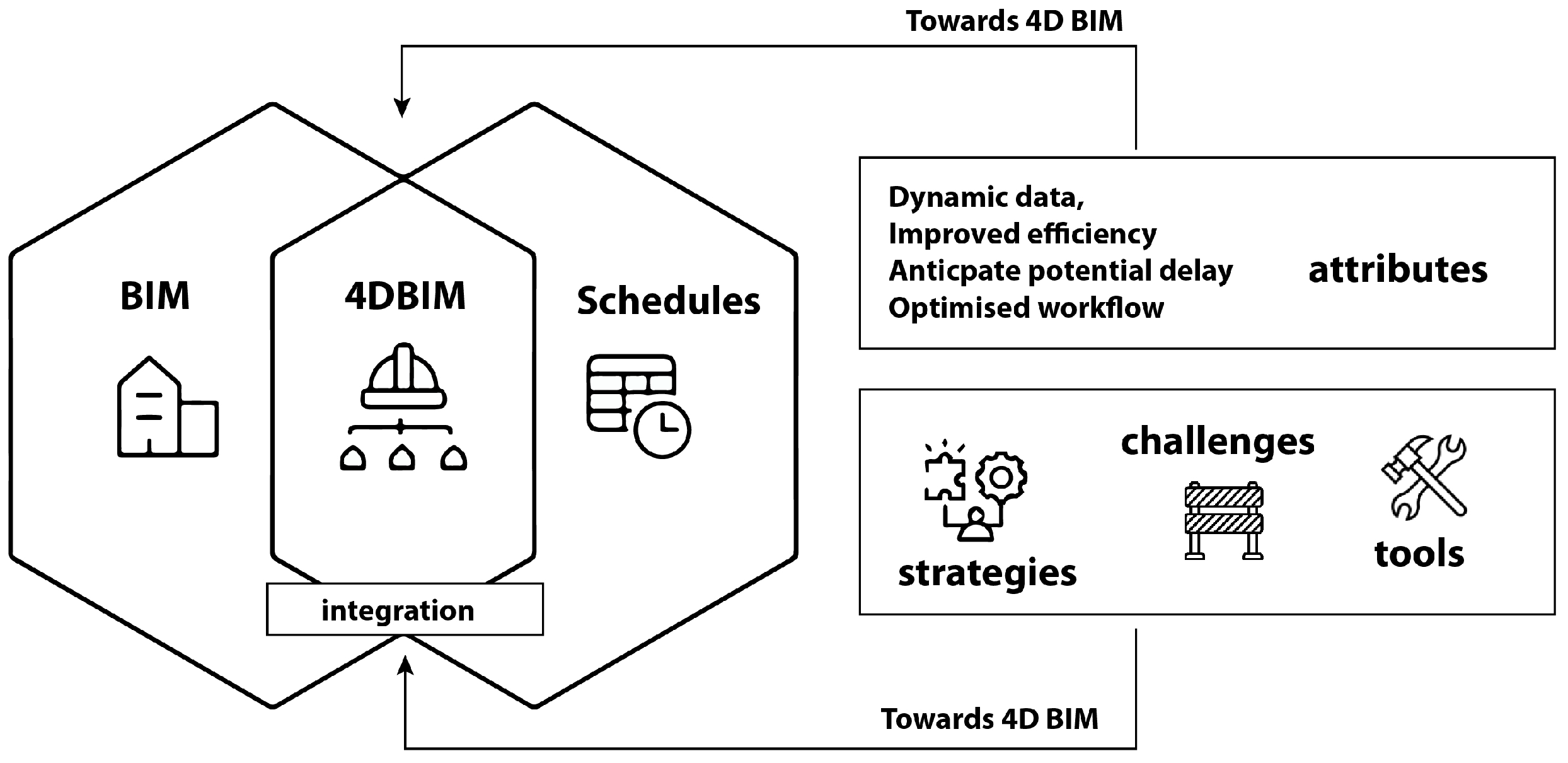

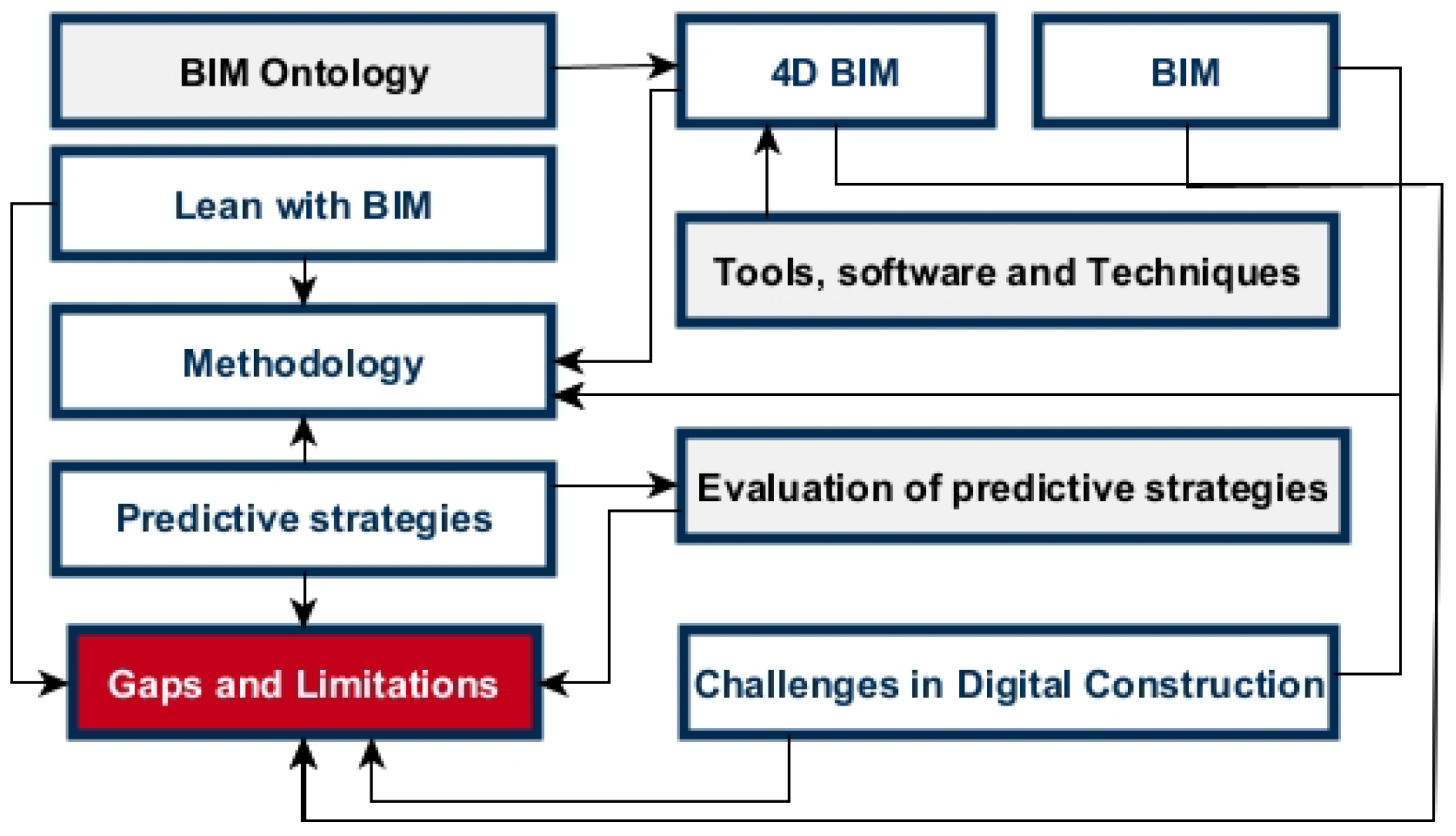


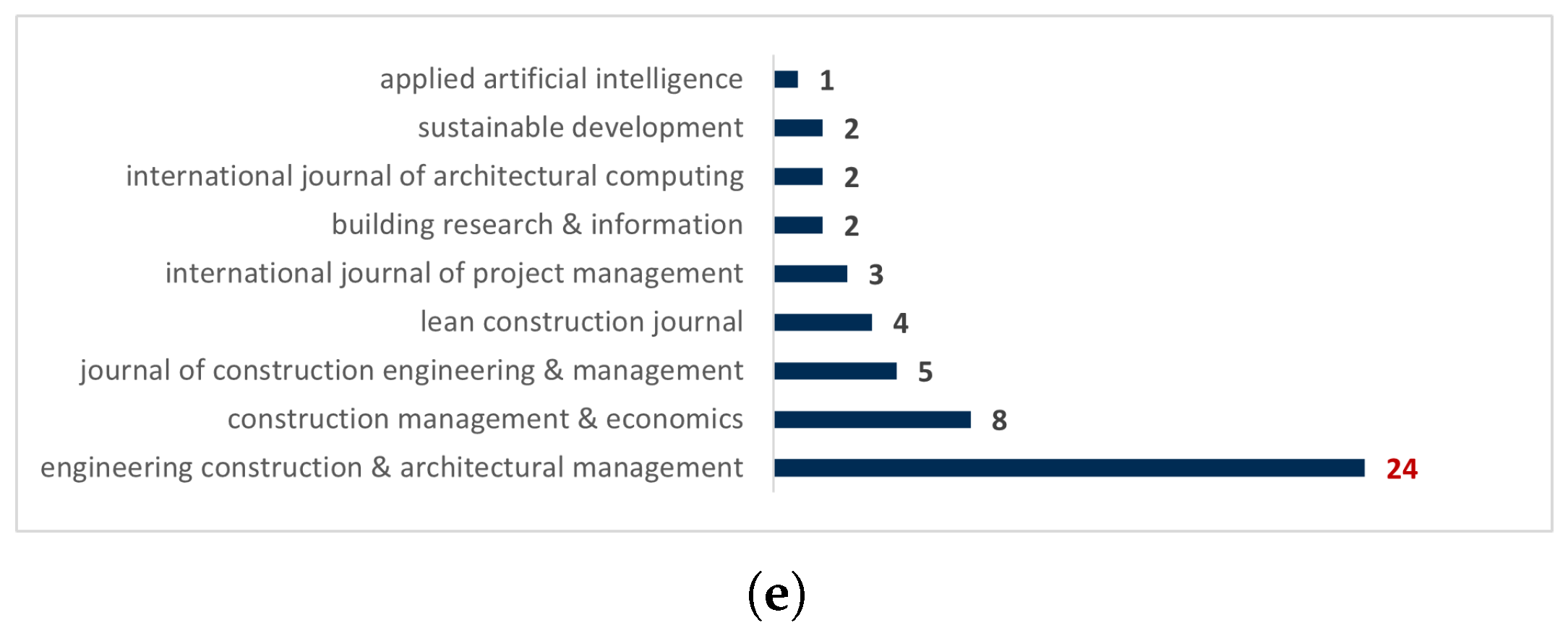

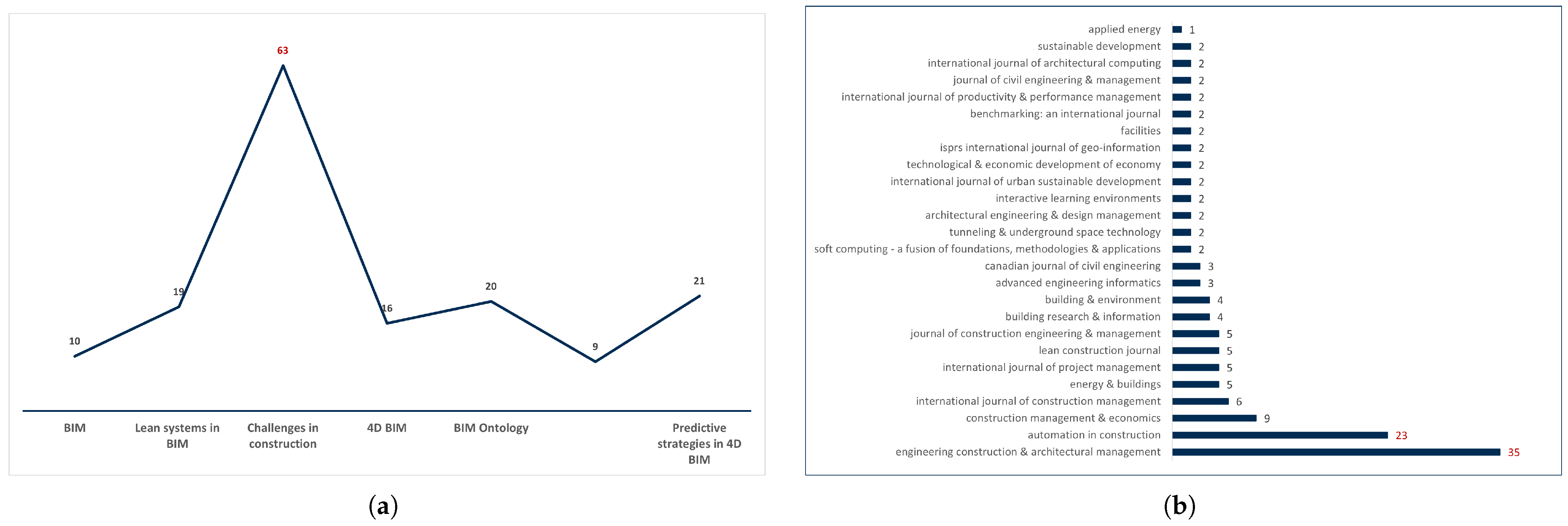
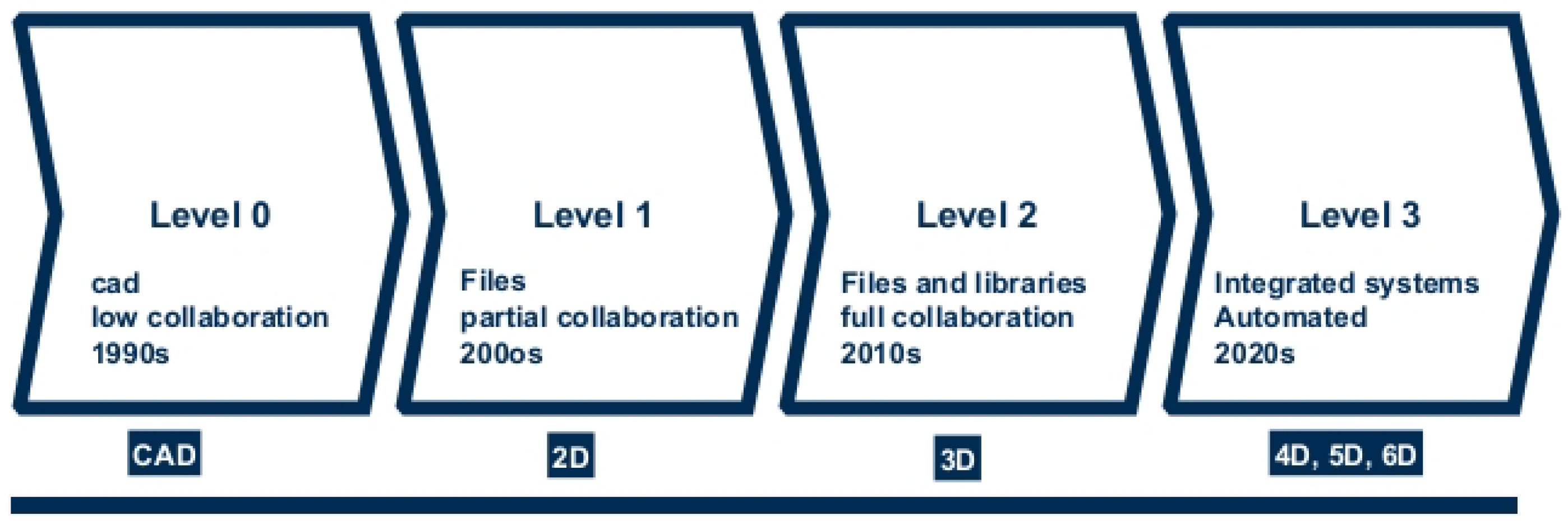
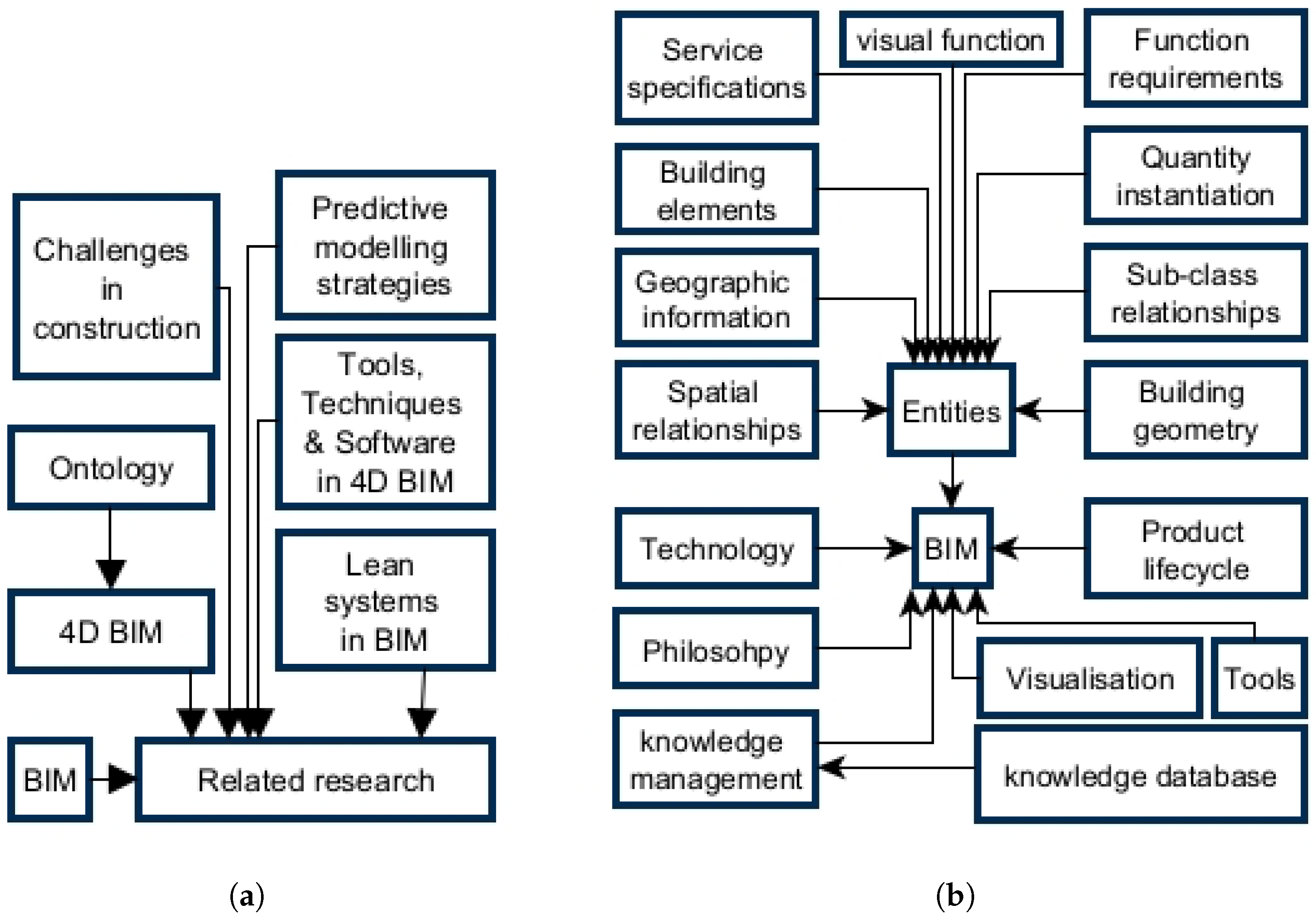
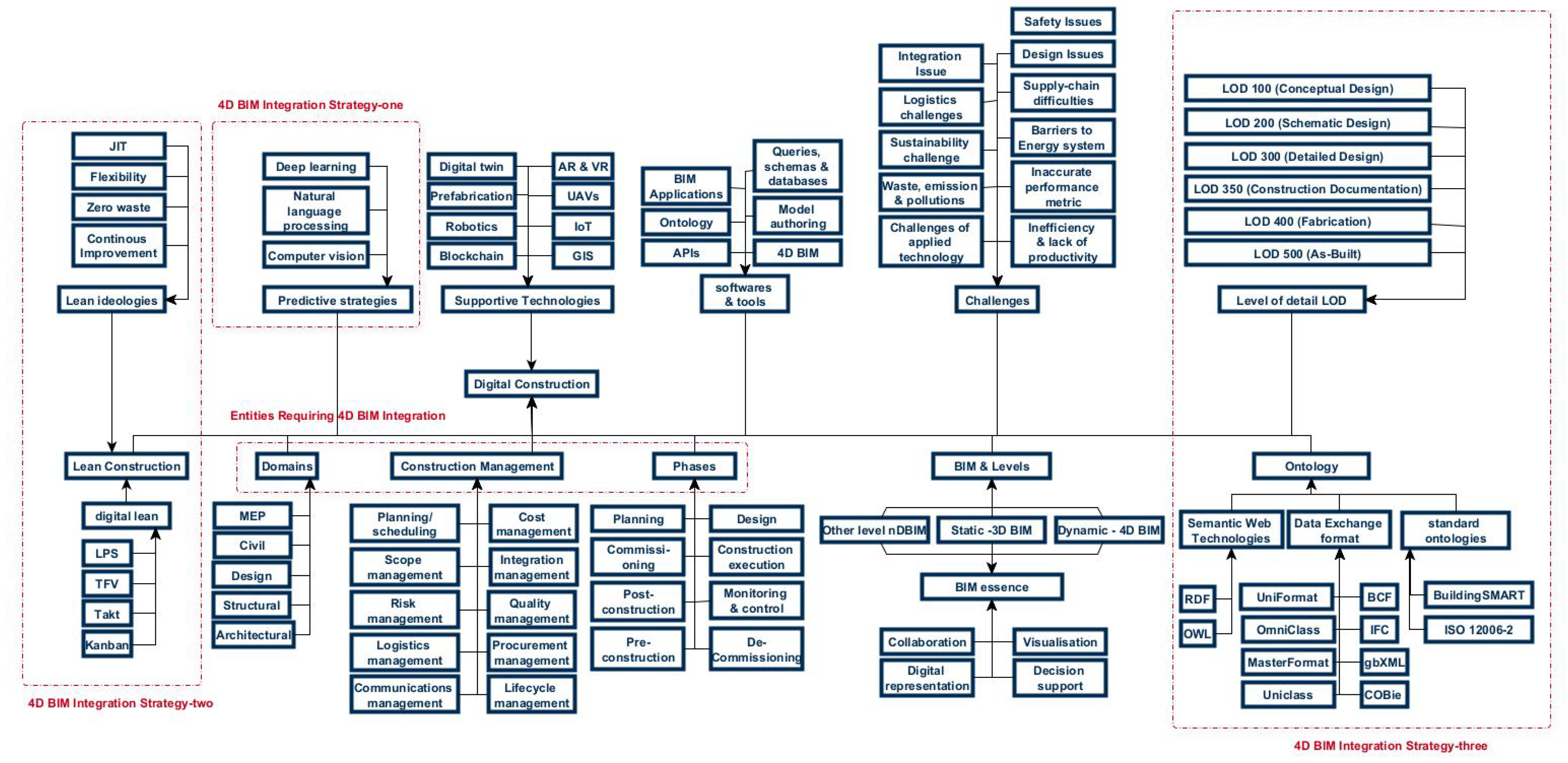

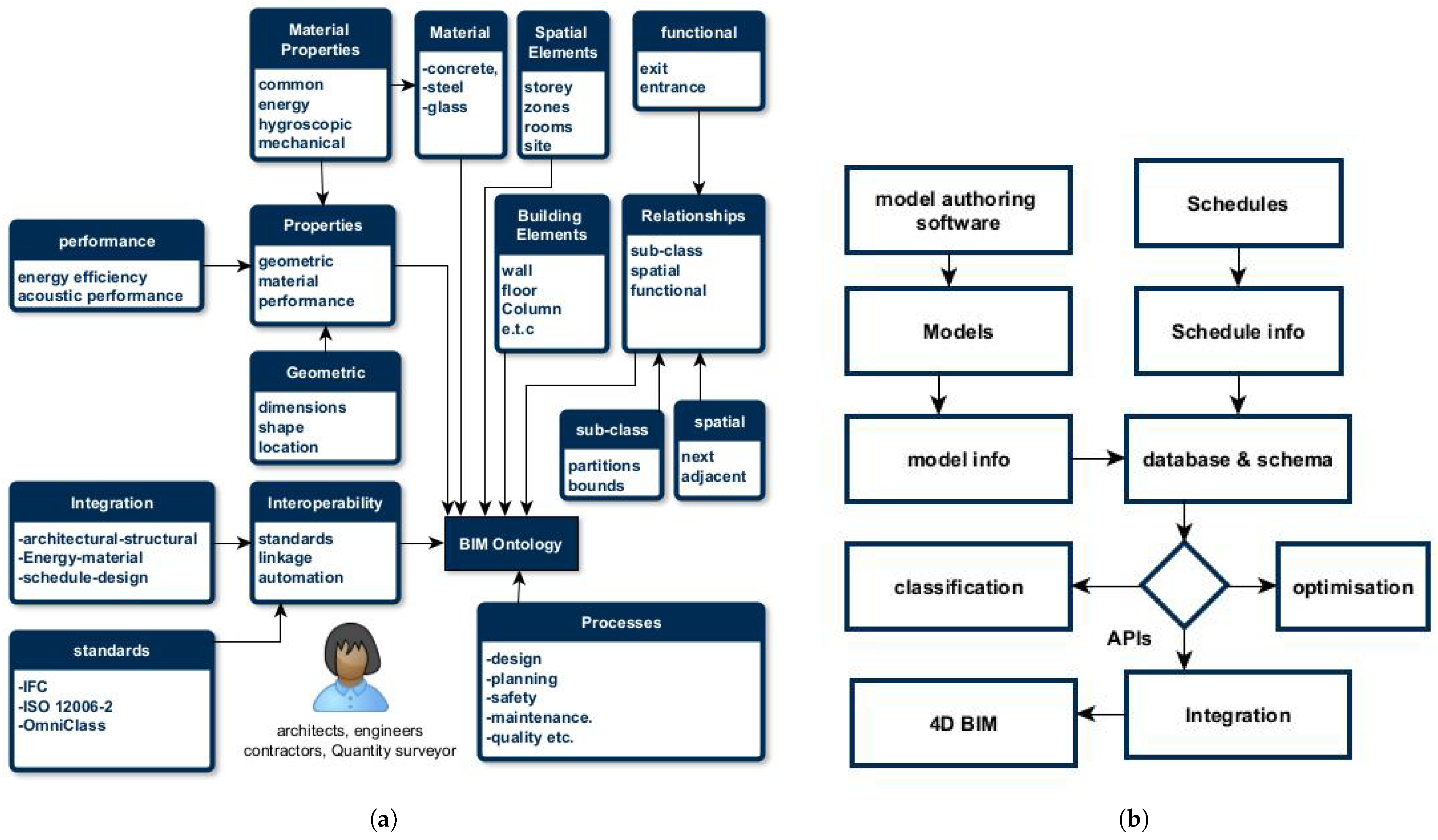
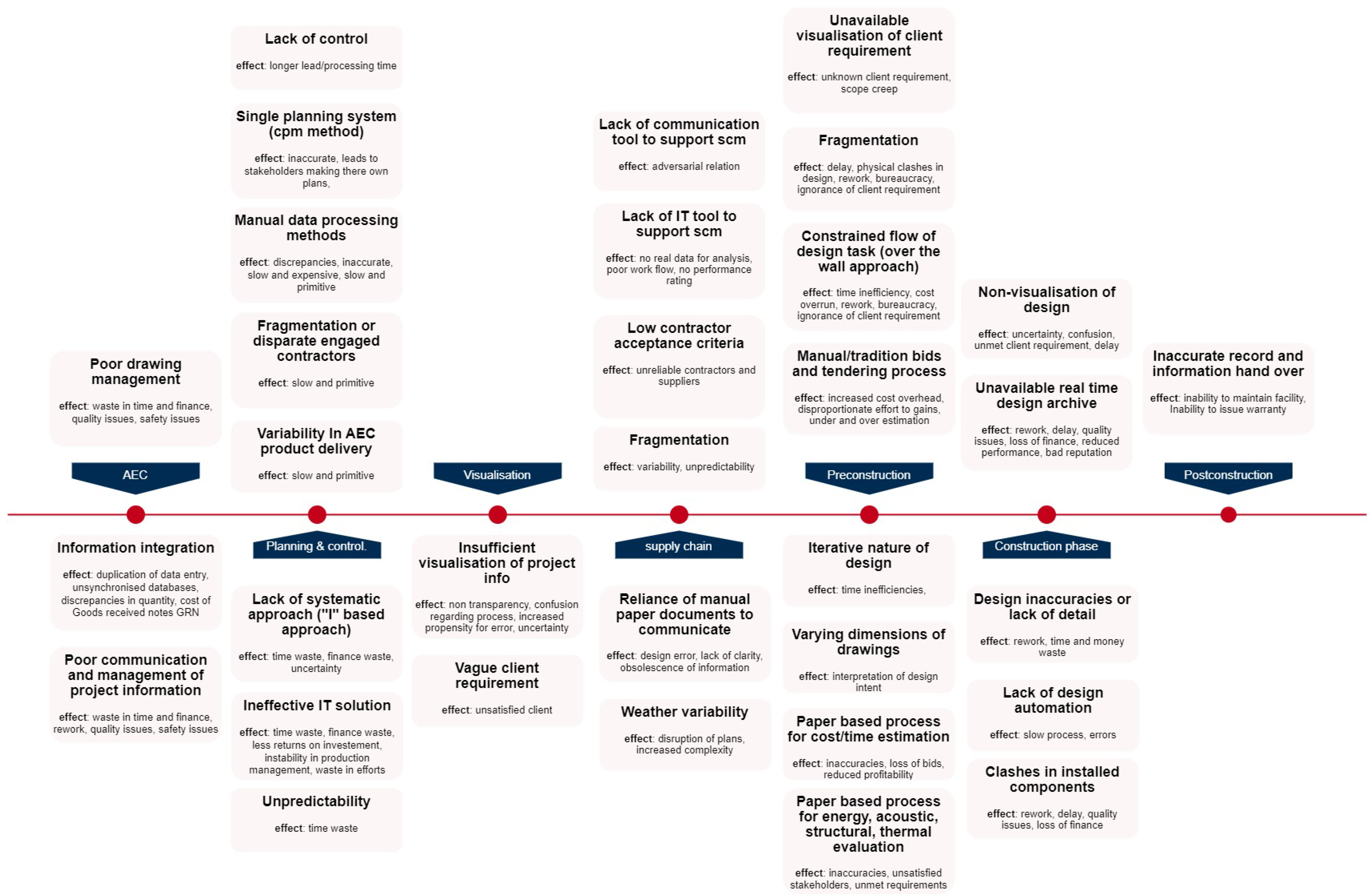


| SubTopic | Search String | Search Field |
|---|---|---|
| BIM | “3d bim” OR “bim” OR “building information modeling” OR “building information management” AND “survey” OR “literature review”. | Title |
| Lean systems in BIM | ”lean” OR “lean construction” OR “lean methodology” AND “bim” or “building information modeling” or “digital construction” or “AEC *” | Title |
| Challenges in construction | ”fragmentation” OR “Integration” OR “Adoption” OR “Implementation” OR “Cost” OR “Communication” OR “Collaboration” OR “Interoperability” OR “Sustainability” OR “Security” OR “Complexity” OR “Design” OR “Data” OR “Legal” OR “regulatory” OR “Standard” OR “Compliance” OR “Stakeholder” OR “Automation” OR “Skill” OR “Training” AND “Challenge” OR “Barrier” OR “Obstacle” OR “Issue” OR “Hurdle” OR “Limitation” OR “Problem” OR “Difficulty” | No field |
| “construction *” OR “construction industry” OR “construction sector” | Subject | |
| “bim” OR “building information modeling” OR “building information *” OR “Information technology” OR “ICT” AND “Bim” OR “building information modeling” OR “building information *” OR “information technology” OR “ICT” | All text | |
| 4D BIM | 4D BIM | Title |
| BIM Ontology | ontolog * AND “bim” or “building information modeling” or “digital construction” or “AEC *” | Title |
| Predictive strategies in 4D BIM | “Computer vision” OR “natural language processing” OR “NLP” OR “machine learning” OR “ML” AND OR “building information modeling” OR “AEC” OR “BIM” | Title |
| Subtopics | Exclusion | Inclusion |
|---|---|---|
| BIM | (1) Non-survey/review papers or case study application studies (2) Papers outside language scope (English) | (1) Survey or review papers regarding BIMs, its adoption, challenges, history, digital progression, etc. |
| Lean systems in BIM | (1) Articles not contributing to bridging the divide between lean construction and BIM (2) Studies including other technologies other than lean and BIM. (3) Paper outside language scope (English) | (1) Studies discussing on lean systems and application in AEC or BIM (2) Studies discussing existing products bridging the gap between lean BIM. |
| Challenges in construction | (1) Short paper columns that was published as article was excluded. (2) Papers from different fields/subject terms such as education, health user acceptance, microbial fuel cells, psychology, ecology, ethics were excluded (3) Surveys or review articles that did not have a specific challenge motivating research to achieve solutions and overcome such challenges were excluded (4) Articles with challenges not pertaining to construction or AEC were excluded (5) Articles written regarding other types of construction asides construction for built assets and physical building are not considered. Material construction, test construction, etc., are disregarded. | (1) Research work with a specific problem that spurs and motivates research (2) Research areas within subject area of construction and construction technology |
| 4D BIM | (1) Articles without 4D BIM as main subject (2) Paper outside language scope (English) | (1) Studies discussing integration methods and frameworks (2) Studies detailing tools, software and techniques |
| Predictive strategies in 4D BIM | (1) Incoherent or poorly organized study documentation | (1) All studies showcasing AI-based technique in AEC phases, design, digital construction, BIM, etc. (2) All studies detailing evaluation basis |
| Subtopic | Full Text | Peer-Reviewed | Language | Academic Journal | Ref. Available | Year | Total |
|---|---|---|---|---|---|---|---|
| BIM | x | x | x | x | 10 | ||
| Lean systems in BIM | x | x | x | x | 19 | ||
| Challenges in construction | x | x | x | x | x | 63 | |
| Four-dimensional BIM | x | x | x | x | 2015 | 16 | |
| BIM Ontology | x | x | x | 20 | |||
| Predictive strategies in 4D BIM | x | x | x | 2020 | 21 |
| Context | Building Information Modeling Description | Citations |
|---|---|---|
| Knowledge resource | NBIMS-US defines BIM as a digital representation of physical appearance and functional capability of a built asset | [2] |
| Collaborative tool | BIM is a virtual system that encompasses all aspects, disciplines, and elements of a facility within a single virtual workspace allowing team members to collaborate more accurately and efficiently than using traditional processes | [1] |
| Content | A BIM comprises the location, geometric details, spatial relationships, quantities and properties of building components with schedules, resource availability, and cost estimates | [1] |
| Geographical location | In the UK, BIM is regarded more as a process than a technology or software. BIM is described as the process of designing, constructing, and operating a building or infrastructure using an object-oriented information system (The British Standards Institution, 2015) | [1,11] |
| Other contexts | Three-dimensional digital representation (model), coordination of design activities, supply chain management system, management method for planning, and life cycle monitoring of products | [11] |
| Citations | Field-Topic | Vis | Perf | Saf | Prom | Sch | Decm | Itgn |
|---|---|---|---|---|---|---|---|---|
| Charlesraj & Dinesh [54] | Status of 4D BIM Implementation in Indian Construction | x | x | x | ||||
| Umar et al. [55] | 4D BIM Application in AEC Industry: Impact on Integrated Project Delivery | x | x | x | ||||
| Park & Cai [56,57] | (1) Framework of Dynamic Daily 4D BIM for Tracking (2) Database-Supported and Web-Based Visualization for Daily 4D BIM | x | x | x | ||||
| Vtt [58] | 4D-BIM for Construction Safety Planning | x | x | |||||
| Montaser & Moselhi [59] | Methodology for Automated Generation of 4D-BIM | x | ||||||
| Raut [61] | Improve the Productivity of Building Project using BIM Based 4D Simulation Model | x | ||||||
| Doukari et al. [60] | The Creation of Construction Schedules in 4D BIM: A Comparison of Conventional and Automated Approaches | x | ||||||
| Bolshakova et al. [62] | Identification of relevant project documents to 4D BIM uses for a synchronous collaborative decision support | x | x | x | x | |||
| Crowther & Ajayi [5] | Impacts of 4D BIM on construction project performance | x | x | x | ||||
| Salman & Hamade [63] | The Integration of Virtual Design and Construction (VDC) With the Fourth Dimension of Building Information Modeling | x | ||||||
| Harris et al. [64] | 4D Building Information Modeling and Field Operations: An Exploratory Study | x | x | |||||
| Martins et al. [65] | Evaluation of 4D BIM tools applicability in construction planning efficiency | x | x |
| Processes | Citations | Krs | Std | Sch | Infr |
|---|---|---|---|---|---|
| Communication | Kwofie et al. [108] | x | |||
| Cost management | Lee et al. [97]; Ren et al. [98] | x | x | x | |
| Design | Ma and Liu [106] | x | x | x | x |
| Integration | Tchouanguem et al. [82]; Shi et al. [103] | x | x | x | x |
| Knowledge management | Lee and Jeong [107]; Niknam and Karshenas [100]; Zhou et al. [92] | x | x | x | |
| Maintenance | Mignard and Nicolle [101]; Hosseini Gourabpasi and Nik-Bakht [8]; Pauen et al. [91] | x | x | x | |
| Monitoring and compliance | Zhong et al. [102]; Jiang et al. [105] | x | x | x | x |
| Planning | Tavakolan et al. [96]; Zheng et al. [85] | x | x | ||
| Quality management | Park et al. [95]; Lee et al. [94] | x | x | ||
| Quantity (multiplicity) | Liu et al. [99] | x | x | ||
| Risk management | Ding et al. [93] | x |
| Phase/Stage | Related Digital Challenges | Citations |
|---|---|---|
| General AEC |
| [1,33,113,114,116] |
| Digital construction |
| [117] |
| Planning and control | Fast-tracked project issues include
| [1] |
| Visualization |
| [9] |
| Supply chain |
| [118] |
| Pre-construction |
| [119,120] |
| Construction phase |
| [121] |
| Post-construction |
| [115] |
| Classification | Software/Tools | Citations |
|---|---|---|
| Model authoring software | Revit, Bentley MicroStation, Tekla, Solibri Model Checker, ArchiCAD | [65,66,67,69,73,75,122,123,124] |
| 4D BIM software | Synchro Pro, Naviswork, Fuzor | [65,66,67,75,77,123,124,125,126] |
| Modeling and Design | Autodesk Maya, Autodesk 3ds, Blender SketchUp, McNeel Rhinoceros (Rhino) | [65,66,73,75,125] |
| Scanners (data capturing) | Faro Focus, Recap | [66,122] |
| Schedulers | Microsoft project, primavera p6, Excel | [65,67,68,71,75,77,123,124,126] |
| API | Autodesk Forge, Trimble Connect, Dynamo, Revit API, BIM 360 API, COMSOL API | [65,66,68,69,73,124] |
| Databases | ODBC, structured query languages SQL, schemas | [66,122] |
| Classifiers and Algorithms | RANSAC, NSGA-II algorithm, multiobjective optimization using GA | [68,71,76,122,123] |
Disclaimer/Publisher’s Note: The statements, opinions and data contained in all publications are solely those of the individual author(s) and contributor(s) and not of MDPI and/or the editor(s). MDPI and/or the editor(s) disclaim responsibility for any injury to people or property resulting from any ideas, methods, instructions or products referred to in the content. |
© 2025 by the authors. Licensee MDPI, Basel, Switzerland. This article is an open access article distributed under the terms and conditions of the Creative Commons Attribution (CC BY) license (https://creativecommons.org/licenses/by/4.0/).
Share and Cite
Awe, M.; Malhi, A.; Budka, M.; Mavengere, N.; Dave, B. Towards 4D BIM: A Systematic Literature Review on Challenges, Strategies and Tools in Leveraging AI with BIM. Buildings 2025, 15, 1072. https://doi.org/10.3390/buildings15071072
Awe M, Malhi A, Budka M, Mavengere N, Dave B. Towards 4D BIM: A Systematic Literature Review on Challenges, Strategies and Tools in Leveraging AI with BIM. Buildings. 2025; 15(7):1072. https://doi.org/10.3390/buildings15071072
Chicago/Turabian StyleAwe, Michael, Avleen Malhi, Marcin Budka, Nicholas Mavengere, and Bhargav Dave. 2025. "Towards 4D BIM: A Systematic Literature Review on Challenges, Strategies and Tools in Leveraging AI with BIM" Buildings 15, no. 7: 1072. https://doi.org/10.3390/buildings15071072
APA StyleAwe, M., Malhi, A., Budka, M., Mavengere, N., & Dave, B. (2025). Towards 4D BIM: A Systematic Literature Review on Challenges, Strategies and Tools in Leveraging AI with BIM. Buildings, 15(7), 1072. https://doi.org/10.3390/buildings15071072







